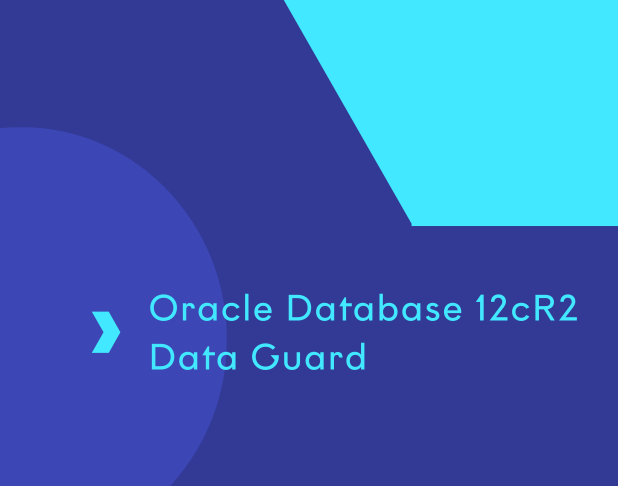Learn how to use Oracle Data Guard in a practical work-relevant setting. You’ll acquire the skills needed to set up, manage and fix standby database configurations. Ideal for DBAs who want to gain the competitive edge for career progression.
Black Friday sale - up to 40% off training courses – use code: BLACKFRIDAY25UAE
Oracle Database 12cR2 Data Guard
Select your learning method

Protect your Oracle systems with enhanced technical skills
This course guides you through the full Oracle Data Guard process: from getting it set up, right through to recovery. You’ll use real tools in live labs and pick up practical ways to protect and maintain your databases on a daily basis.
- Configure Data Guard environments in multitenant architectures
- Perform switchovers and failovers using both SQL and Data Guard Broker
- Automate backup and recovery tasks using RMAN scripts
- Implement flashback operations to recover from user or system errors
- Diagnose and fix issues with redo transport and apply services
- Optimise Data Guard performance through tuning and configuration
- Enable and manage Fast-Start Failover (FSFO) for automatic recovery.
- Build logical standby databases for flexible testing and reporting
What you’ll learn
This course is filled with practical content alongside relevant theory. Led by Oracle experts, you’ll learn how to work with Oracle Data Guard in real scenarios, from setup through to recovery, building confidence as you expand your working knowledge.
Monitoring and troubleshooting
Knowing how to monitor your Data Guard setup is just as important as configuring it. We’ll explore how to keep an eye on system health, check key views and interpret alert logs to catch problems early. We’ll look at how to identify gaps, fix common sync issues, and understand what’s happening throughout the complete setup. You’ll also get practical tips for diagnosing issues before they become more concerning and learn what to do for a successful resolution.
Role transitions
This part of the course shows you how to switch roles between primary and standby databases with ease. You’ll practise both planned switchovers and emergency failovers using SQL and the Data Guard Broker. We’ll show you how to prepare both databases, run the transition smoothly, and reinstate your original primary if needed. You’ll also learn how to preserve active sessions and use features like application continuity to minimise user disruption. It’s essential learning if you’re responsible for high-availability Oracle systems.
Performance tuning
Getting the most out of your standby database setup means fine-tuning how it handles workloads. In this module, we cover practical performance tips for both physical and logical standby environments. You’ll look at settings like ReopenSecs, NetTimeout, and redo compression. We’ll also dive into SQL Apply tuning, applier/preparer process adjustments, and memory configuration for LCR caches. There’s even support for tools like SQL Tuning Advisor and the Diagnostic Pack. By the end, you’ll know how to identify slow spots and make your standby setup faster and more efficient.
- 4 days of live virtual training
- Hands-on labs to practise as you go
- Digital course materials tailored to Oracle 12cR2, 18c and 19c
- ILX certificate of attendance
- Expert instruction from experienced Oracle practitioners
- Flexible scheduling for private or team sessions
Key facts
Oracle DBAs, system engineers and support staff who want to build confidence with Data Guard.
You’ll need solid Oracle DBA experience and be comfortable working in a Linux or UNIX environment. If you’re newer to this, we recommend taking our Oracle admin and RMAN backup courses first.
Our experienced trainers and interactive labs create a focused, practical environment – so you can put theory into practice from day one. (Do not change this copy)
FAQs
This focused course gives you the tools to manage Oracle Data Guard confidently, from setup through to recovery. With expert instructors and hands-on live labs, it’s ideal for anyone managing Oracle systems where uptime and continuity really matter.
What is Oracle Data Guard?
Oracle Data Guard is a high-availability feature used to protect your Oracle database from unplanned outages. It creates standby copies of your database that can automatically take over if the primary system fails. It’s widely used in environments where downtime isn’t an option.
Will this course help with real-world Oracle Data Guard tasks?
Yes, the whole course is built around practical tasks you’ll face as a DBA. You’ll learn how to configure standby databases, manage role transitions, monitor your setup, and recover quickly if something goes wrong. It’s all based on real scenarios you’re likely to see on the job.
What is the difference between physical, logical and snapshot standby databases?
A physical standby database is an exact copy of the primary, kept in sync through Redo Apply. A logical standby uses SQL Apply, allowing read-write access for reporting or testing. A snapshot standby is read-write and isolated from the primary, ideal for testing changes. You’ll work with all three in this course.
How does this course help reduce database downtime?
By learning to implement Oracle Data Guard properly, you’ll be able to switch to standby databases during outages, perform role transitions efficiently, and recover quickly from failures – all essential to minimising downtime in production environments
What our customers say

‘Good structure to course. Each technical aspect broken down by instructor and theory explained with practical examples, which aided understanding and provided guidance on best practice when applying in real life scenarios. Pace was good - fast enough to keep engaged, and not too overwhelming.’

‘The lecturer was amazing - so passionate and knowledgeable, which made the sessions really enjoyable and easy to follow. I learned a lot and felt supported throughout. I would definitely consider returning for future sessions and highly recommend ILX to my colleagues.’
Join the half a million learners developing their skills with our training
A trusted partner to thousands of organisations worldwide
Our passionate team goes above and beyond to support customer needs
Please complete the form to ensure your quote is accurate and we will contact you soon.